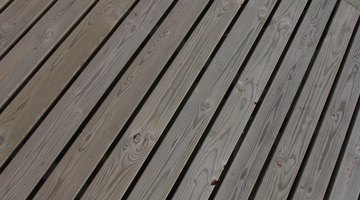Does Linseed Oil Help Preserve Wood?
Linseed oil, pressed out of the flax seed, is a common outdoor wood preservative. It soaks deep into the wood, protecting it against water infiltration, which leads to rot. While linseed oil was historically used as a wood preservative, it does have drawbacks such as slow dying times.

Modern chemistry developed superior products, which mimic the positive attributes of linseed oil while eliminating the drawbacks.
Early Uses
Around the 1400s, art painters replaced egg with linseed oil as the fluid in their paints. Because it dries slowly, it gave them more time to work with the paint. Since then, society has coated wood with either pure linseed oil or exterior paints made with linseed oil, according to building experts and architects E. Brandt and T. Lading of the Danish Building and Urban Research and the Lading Architects and Consultants, respectively.
Application
The application of linseed oil is easy. Obtain a disposable paintbrush, and brush it on unfinished wood. Apply several layers until the wood stops absorbing oil. As an alternative, wipe an oil-soaked rag across the wood. You must take one caution, however: Rags and brushes soaked with linseed oil heat up and spontaneously combust. Do not throw away oil-soaked tools in a garbage can, since the danger of fire is great. Rather, take them to your local hazardous materials disposal center, where trained professionals know how to deal with oil-soaked items.
Oil Uses
A difference exists between boiled linseed oil and raw oil. Boiled linseed oil is not really boiled, but several synthetic agents are added to speed up the dying time. These agents are toxic, so any wood coming into contact with edibles should be coated with raw rather than boiled. Alice Elliott, University of Maine Extension master gardener volunteer for Kennebec County, recommends soaking outdoor tool handles with linseed oil. Overall, you can coat any wood with linseed oil. The decision to use raw or boiled depends on the application.
Modern Preservatives
Linseed oil has several drawbacks, one of which is its slow drying time. It will remain tacky for days, possibly even months, depending on the weather and humidity. Another drawback is that it provides no ultraviolet light resistance, so decks will eventually turn gray. Furthermore, since it's a natural product, it will eventually biodegrade. You must recoat yearly — especially on wood in contact with the ground. Because of these drawbacks, modern wood preservatives are made with complex chemicals that eliminate the drawbacks but still keep the positive attributes of linseed oil.
References
Writer Bio
Tony Oldhand has been technical writing since 1995. He has worked in the skilled trades and diversified into Human Services in 1998, working with the developmentally disabled. He is also heavily involved in auto restoration and in the do-it-yourself sector of craftsman trades. Oldhand has an associate degree in electronics and has studied management at the State University of New York.
Photo Credits
- Hemera Technologies/AbleStock.com/Getty Images
- Hemera Technologies/AbleStock.com/Getty Images
More Articles



